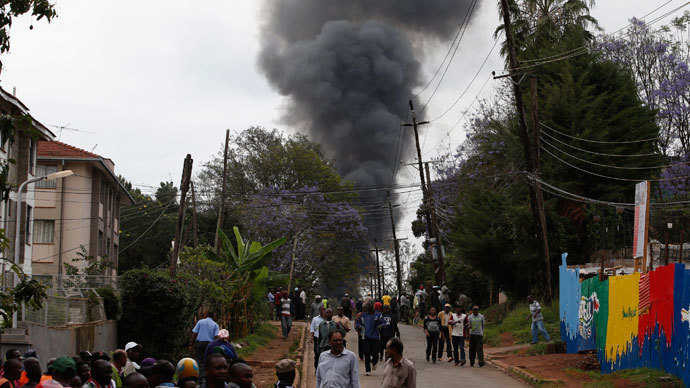A crash course in Somalization, from Syria to Kenya

So what was Harakat al-Shabaab al-Mujahideen - the Al-Qaeda-linked Somali outfit - really up to in Kenya?
A mall in the capital of East Africa’s biggest economy, part owned by Israelis, offering the “supreme experience of shopping” for the local elite and upper middle class, diplomats and expats. It seems to be the perfect target for an attack with minimal logistics (assault rifles and grenades) and bent on inflicting maximum casualties.
But was it just ‘senseless terror’? Blowback? Or a game of
shadows?
I’ve been trying to travel across Somalia for years, but contacts have always stressed; for a lone Westerner with no ‘protection’ – not to mention a lot of ammo – that’s certified suicide. The best one can do is to try to piece together the jigsaw puzzle.
Al-Shabaab split
Originally, al-Shabaab (Mujahideen Youth Movement) derives from
the Islamic Courts movement that was in power in Somalia until
they were repelled by invading Ethiopian troops in
2007.
It’s crucial to keep in mind that a great number of Somalis –
including businessmen - praised the Islamic Courts for bringing
back some measure of security and disarming countless militias,
something the country had not experienced since the early 1990s.
That feeling even superseded the fact the courts wanted to establish Sharia law and forbid everyone from listening to music and chewing khat. So the courts had strong social support. And yet, predictably, the Bush administration at the time branded them as “terrorists”.
Al-Shabaab remained one of the factions active in Mogadishu until the summer of 2011. But then they were kicked out of the capital and also kicked out of the port of Kismayu, their main base, later in 2012. AMISOM – the not-exactly-peacekeeping, somewhat fighting forces of Kenya, Ethiopia and Uganda, among others, under the umbrella of the African Union – was gradually ramping up the pressure.

Al-Shabaab’s power base remains unbelievably poor rural Somalia. Until recently the group was led mostly by Somali clan elders. A smatter of foreign jihadis with ground experience from Afghanistan to the Maghreb is to be found. But the bulk of the fighting force is essentially composed of bored teenagers bought by roughly $300 and the vision of meeting 72 virgins in paradise.
The crucial al-Shabaab/Al-Qaeda link also dates from 2012. Some
al-Shabaab leaders not only disagreed, but decided to vote with
their feet. After all, al-Shabaab had always been essentially
about Somali nationalism.
Al-Shabaab’s internal split is crucial to understand the full
picture. After important defections and certainly gruesome
executions, for the past three months Emir Abu Zubayr seems to be
fully in charge. He is not a Somali nationalist, like the
defectors; he wants to pursue the aiming-for-a-globalized-emirate
Al-Qaeda way.
What is Kenya up to?
Al-Shabaab duly claimed the attack on Westgate mall via their Twitter account. A fog of witnesses claim the attackers did not speak Swahili, but Arabic or Somali; some were disguised as women; and they might have even included a notorious female British jihadi, the so-called “white widow” Samantha Lewthwaite. In sum: a mini-Jihad Inc.
Al-Shabaab stressed only “infidels” were killed in the raid, and
made sure this was revenge against invading Kenyan troops active
in Somalia since 2011. Previous attacks in Mogadishu this year
featured a car bomb and a suicide bomber, but no attempt to take
hostages. Here is an excellent summary of why Kenya,
and why now, written by the son of my late friend and former Asia
Times editor Tony Allison.
Nairobi’s long game is to protect its two key industries – the
safari trail and shipping (centered on the port of Mombasa). This
has evolved into the strategy of creating a buffer state in
southern Somalia. Not by accident, in this region, Jubaland, a
lot of unexplored oil wealth is the key part of the story.
That’s the background for the Kenyan invasion of southern Somalia in 2011 - when al-Shabaab was kicked out of Kismayu. Very important; the US and France were key in the military support department. Kenya’s army, frankly, is a joke, and would never pull it off by itself. The invasion was effusively hailed in the West and – where else? - the UN Security Council.
It's because Kenya expelled al-Shabaab from Kismayu that AMISOM managed to further secure Mogadishu – with Kenyan troops included in the mix. And yet, also predictably, Kenya’s adventure in southern Somalia was seen by most Somalis as an occupation, not a liberation.

So here we find the embryo of blowback. The Kenyan invasion managed to fire up Somali popular support for al-Shabaab all over again; people even forgot that for a long while al-Shabaab chose to let Somalis die in droves, victims of famine, instead of accepting Western aid.
Thus Kenya acting as a US-France puppet ultimately provoked the Westgate mall blowback. Not to mention that Washington has been droning Somalia non-stop from a base in neighboring Djibouti.
Dick Cheney’s Al-Qaeda dream
But all this is only part of the story. For the Big Picture, we
need to go back to NATO’s ‘humanitarian’ bombing of Libya into a
failed state; a development that spawned the Libya-Syria
connection.
We need to remember that Al-Qaeda in the Islamic Maghreb (AQIM)
had merged with the Libyan Islamic Fighting Group (LIFG) in 2007;
this was announced by Ayman al-Zawahiri himself. After the
destruction of Libya, AQIM invaded northern Mali – which led to
yet another French delirium of grandeur. And then the LIFG, now
‘supported’ by NATO, activated the connection with Syria – with
jihadis, funds and weapons fueling non-stop the so-called ‘Free’
Syrian Army.
In parallel, al-Shabaab also connected to the LIFG and AQIM; and,
ultimately, they all connected with - guess who - Al-Nusra Front
in Syria. Even the head of AFRICOM, Gen. Carter Ham, had to admit part of the story in 2012.
In fact this was no admission; it was supposed to happen. NATO
propelling the Libya-Syria connection would inevitably expand Al-
Qaeda’s operational reach, from AQIM to AQAP and by extension
al-Shabaab. The serpent bites its own tail; a Western military
offensive leads to scattered jihadi response; blowback ensues;
and thus the need for more Western military muscle, ad
infinitum.
So yes; LIFG, AQIM, AQAP, Boko Haram in Nigeria, al-Shabaab, Al-Nusra Front; this acronym/branding spectacular is all interconnected. When manipulated by the US and asserted European poodles as a geopolitical switch – which can be turned on and off – it works wonders.
From Washington’s point of view, to have it reactivated on and off is essential to keep the so-called “light footprint” in Africa, which Nick Turse conclusively demonstrated is anything but light.
Whenever jihadi blowback happens, that’s perfect to ramp up Western hysteria – and demonization of Muslims in general. Moreover, the Westgate mall attack will be the perfect pretext to ramp up US and UK ‘efforts’ inside Somalia. Shady ‘foreign assistance teams’ from the US, UK and Israel, after all, are already in place and crucially deploying from bases in Kenya.
Somalis who have nothing to do with al-Shabaab may and will pay
the price – as much as Syrians who detest Al-Nusra Front are
victims of the West’s blind, blank support of ‘rebels’. Dick
Cheney must feel vindicated; the West is finally consolidating
his ‘vision’ of Al-Qaeda as a mercenary shadow army disguised as
global Terror Inc. And everything’s under control, of course.
Except the wretched ‘collateral damage’ caught in the crossfire.
The statements, views and opinions expressed in this column are solely those of the author and do not necessarily represent those of RT.
The statements, views and opinions expressed in this column are solely those of the author and do not necessarily represent those of RT.













